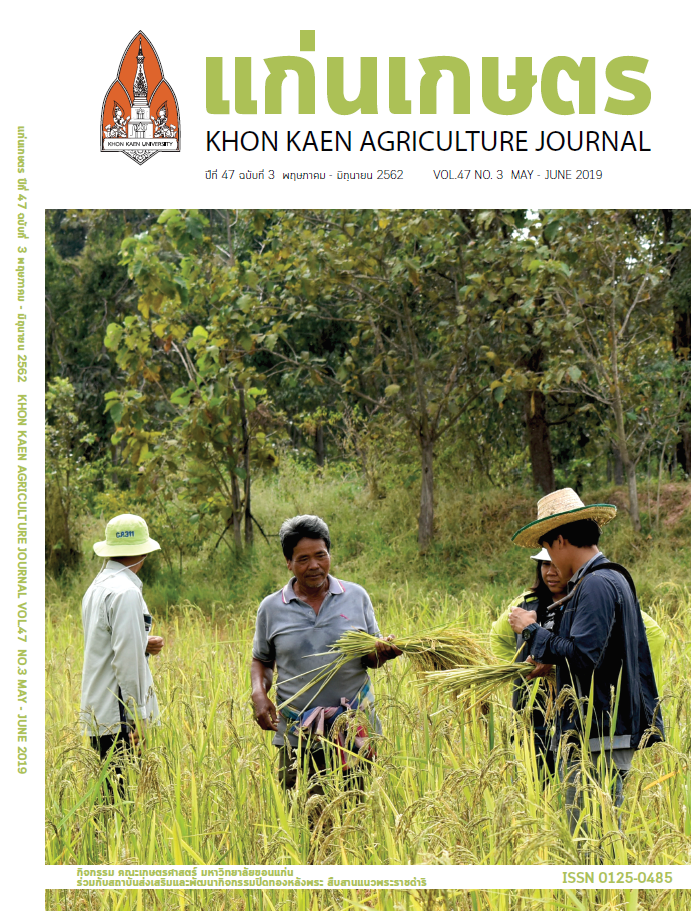ผลของอุณหภูมิสูงในระยะเจริญพันธุ์ที่มีต่อการติดเมล็ดและคุณภาพเมล็ดพันธุ์ข้าว
Main Article Content
บทคัดย่อ
สภาวะที่อุณหภูมิของโลกเพิ่มขึ้นส่งผลกระทบโดยตรงต่อการผลิตข้าว ทำให้ความมีชีวิตของละอองเกสร และการติดเมล็ดลดลง ดังนั้นจึงได้ศึกษาผลของอุณหภูมิสูงในระยะเจริญพันธุ์ที่มีต่อการติดเมล็ดและคุณภาพเมล็ดพันธุ์ วางแผนการทดลองแบบ split-plot in CRD จำนวน 2 ซ้ำ ประกอบด้วย ปัจจัยหลัก คือ สภาพแปลงธรรมชาติ และโรงเรือนที่ควบคุมอุณหภูมิสูง (40±5°C) และปัจจัยรอง คือ ข้าวจำนวน 14 พันธุ์ ปลูกข้าว ทุกพันธุ์ในกระถางแล้วตั้งไว้ในสภาพแปลงภายนอกโรงเรือน เมื่อข้าวเริ่มเข้าระยะตั้งท้อง (R2) ย้ายข้าวจำนวน 10 กระถางในแต่ละพันธุ์เข้าสู่โรงเรือนที่ควบคุมอุณหภูมิสูง จนถึงระยะเก็บเกี่ยว (R9) เปรียบเทียบกับสภาพแปลงธรรมชาติ ผลการทดลองพบว่า อุณหภูมิสูงในระยะเจริญพันธุ์มีผลทำให้จำนวนรวง/กอ นำ้หนักรวง/กอความยาวเมล็ด น้ำหนักเมล็ดดี/รวง การติดเมล็ด น้ำหนัก 100 เมล็ด ผลผลิต/กอลดลง ในสภาพอุณหภูมิสูง พันธุ์ข้าวที่มีการติดเมล็ดสูง (>75 %) ได้แก่ N22 ชัยนาท 1 และ กข49 พันธุ์ข้าวที่มีระดับความทนร้อนปานกลาง (ติดเมล็ด 50-74%) ได้แก่ กข29 กข31 กข41 กข47 กข55 กข61 กข63 สุพรรณบุรี 60 และ พิษณุโลก 2 ในขณะที่พันธุ์ที่ไม่ทนร้อน (ติดเมล็ด <50%) ได้แก่ ปทุมธานี 1 สินเหล็ก และ กข15 นอกจากนี้อุณหภูมิสูงมีผลทำให้ความแข็งแรงโดยวิธีการเร่งอายุลดลง แต่ไม่มีผลต่อความงอกของเมล็ดพันธุ์ข้าวทุกพันธุ์ ยกเว้น กข15 และสินเหล็ก ในขณะที่ สุพรรณบุรี 60 กข41 และกข29 ยังคงมีความแข็งแรงโดยวิธีการเร่งอายุสูงกว่า 80%
Article Details
เอกสารอ้างอิง
กรมการข้าว. 2559. แผนการผลิตเมล็ดพันธุ์ข้าว ปี 2560. แหล่งข้อมูล: http://brs.ricethailand.go.th/images/PDF/Plan_update_060160.pdf. ค้นเมื่อ 11 สิงหาคม 2561.
กรมอุตุนิยมวิทยา. 2560. ความรู้ด้านอุตุนิยมวิทยา (ภาวะเรือนกระจก). แหล่งข้อมูล: https://www.tmd.go.th/info/info.php?FileID=20. ค้นเมื่อ 12 มีนาคม 2560.
ชลลดา ถาคำมี. 2545. อิทธิพลของอุณหภูมิสูงในระยะตั้งท้อง และผสมเกสรต่อการผสมเกสร และองค์ประกอบผลผลิตของข้าวนาปรังในภาคตะวันออกเฉียงเหนือ. วิทยานิพนธ์ป ริ ญ ญ า วิ ท ย า ศ า ส ต ร ม ห า บั ณ ฑิ ต มหาวิทยาลัยขอนแก่น, ขอนแก่น.
Cheabu, S., P. Moung-ngam, A. Arikit, A. Vanavichit, and C. Malumpong. 2018. Effects of heat stress at vegetative and reproductive stages on spikelet fertility. Rice Sci. 25 (4): 218-226.
Ellis, R.H. 2011. Rice seed quality development and temperature during late develop- ment and maturation. Seed Sci. Res. 21: 95-101.
Ellis, R.H., and T.D. Hong. 1994. Desiccation tolerance and potential longevity of de- veloping seed of rice (Oryza sativa L.). Ann. Bot. 73: 501-506.
Ellis, R.H., T.D. Hong, and M.T. Jackson. 1993. Seed production environment, time of harvest, and the potential longevity of seed of three cultivars of rice (Oryza sativa L.). Ann. Bot. 72: 583-590.
IRRI. 2013. Standard evaluation system for rice. 5th edition. International Rice Research Institute, Philiippins.
ISTA. 2016. International Rules for Seed testing. Seed Science and Technology. Zurich, Switzerland.
Jagadish, S.V.K., R. Mathurajan, R. Oane, T.R. Wheeler, S. Heuer, J. Bennett, and P.Q. Carufurd. 2010. Physiological and proteomic approaches to address heat tolerance during anthesis in rice (Oryza sativa L.). J. Exp. Bot. 61: 143-156.
Madan, P., S.V.K. Jagadish, P.Q. Craufurd, M. Fitzgerald, T. Lafage, and T.R. Wheeler. 2012. Effect of elevated CO2 and high temperature on seed set and grain quality of rice. J. Exp. Bot. 63 (10): 3843-3852.
Martinez-Eixarch, M. and R.H. Ellis. 2015. Temporal sensitivities of rice seed development from spikelet fertility to viable mature seed to extreme-temperature. Crop Sci. 55: 354-364.
Matsui, T., K. Omasa, and T. Horie. 2000. High temperatures at flowering inhibit swell- ing of pollen grains, a driving force for thecae dehiscence in rice (Oryza sativa L.). Plant Prod. Sci. 3: 430–434.
Morita, S., Y. Jun-Ichi, and T. Jun-Ichi. 2005. Growth and endosperm cell size under high night temperatures in rice (Oryza sati- va L.). Ann. Bot. (Lond.). 95: 695–701.
Oh-e, I., K. Saitoh, and T. Kuroda. 2007. Effects of high temperature on growth, yield and dry-matter production of rice grown in the paddy field. Plant Prod. Sci. 10: 412-422.
Peng, S., J. Huang, J.E. Sheehy, R.C. Laza, R.M. Visperas, X. Zhong, G.S. Khush and K.G. Cassmon. 2004. Rice yield decline with higher night temperature from global warming. Proc. Natl. Acad. Sci. USA 101: 9971-9975.
R Core Team. 2017. R: A language and environment for statistical computing. R Foundation for Statistical Computing, Vienna, Austria.
Satake, T., and S. Yoshida. 1978. High temperature induces sterility in indica rice at flowering. Jpn. J. Crop Sci. 47: 6-17.
Xie, X.J., B.B. Li, Y.X. Li, and S.H. Shen. 2009. High temperature harm at flowering in Yangtze River basin in recent 55 years. Jiangsu J. Agric. Sci. 25: 28-32.
Yoshida, S. 1981. Fundamental of Rice Crop Science. International Rice Research Institute, Los Banos, Philippines.


